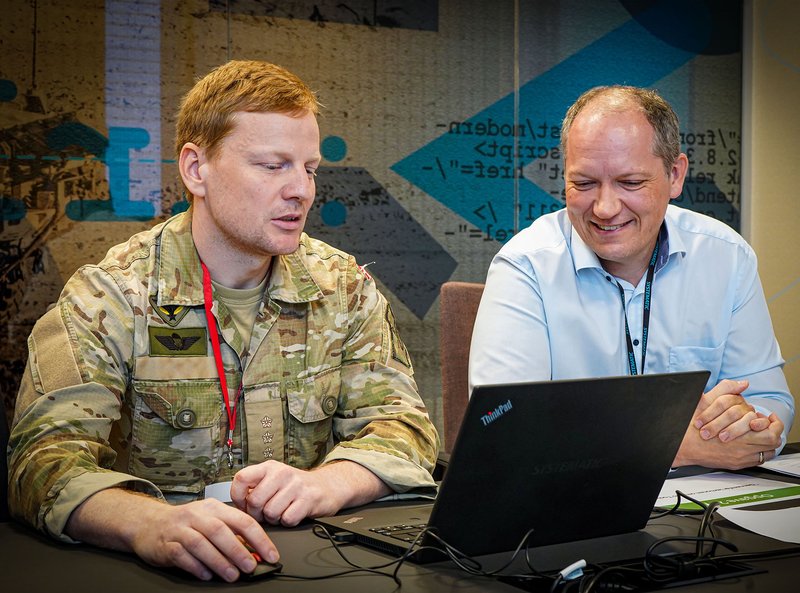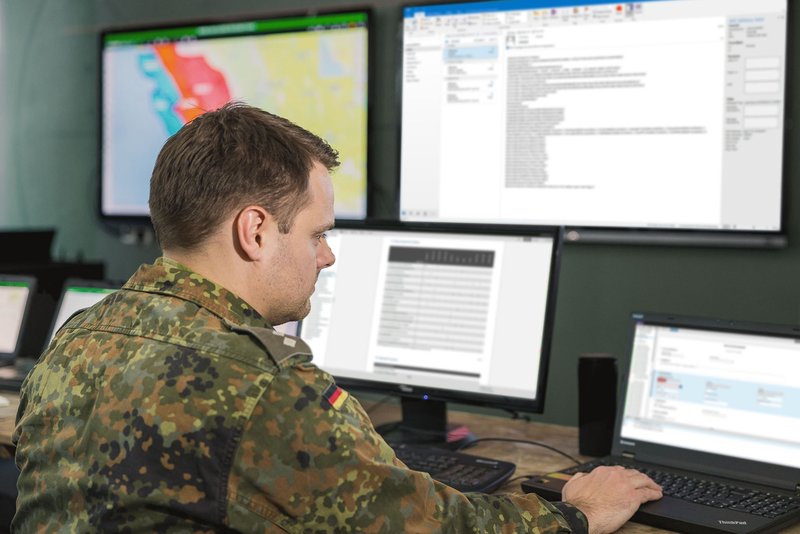Solving key multidomain challenges for major alliances
This article is brought to you by Systematic
There are a number of challenges to unleashing true multidomain operations that are made more difficult when operating across complex alliances.
Multidomain operations go beyond simply incorporating cyber and space domains into traditional joint operations. It aims to provide commanders with access to data and information from all domains, enabling simultaneous and sequential operations through integrated capabilities. This requires a shift from a "need-to-know" mentality to a "need-to-share" approach, ensuring the timely dissemination of information to commanders and government decision-makers.
Developing training and doctrine
With each member state of a coalition bringing a diverse range of values and traditions with it, each member is ultimately bringing in unique experiences, perspectives, and priorities. Leveraging these can bring benefits, as the utilisation of combat and operational experience can support those partners who lack this experience to draw from.
To ensure that the true power of multidomain operations can be unleashed, investment in cross-domain training programmes to help enable new mindsets needs to be undertaken. This helps to deliver new methods of problem-solving, as well as awareness of the pain, pressures, and capabilities of elements within a coalition.
In moving the training into practice, establishing and exercising cohesive doctrines around multidomain operations and the use of force helps to deliver a comprehensive strategy. A well-defined doctrine provides a common framework for planning and executing multi-domain operations, ensures that alliance forces operate effectively.
Doctrine also needs to remain adaptable and responsive to emerging threats and technologies. Mechanisms should also be put in place for regular updates and revisions to ensure that the doctrine remains relevant. The development should also be done iteratively using feedback of lessons-learned to gradually build support of the full kill-chain. This process should involve collaboration with experts from various domains, including cyber, space, and information warfare, to ensure a comprehensive and future-proof approach.

Transforming organisational structures
Traditionally, military forces have operated within their respective domains, such as land, sea, and air, with limited cross-domain coordination. Yet multidomain operations require a fundamental shift in thinking, encouraging military leaders to embrace a more holistic and integrated approach to warfare.
Military personnel at all levels must be prepared to adapt to a new operational paradigm that demands cooperation and coordination across the individual arms. Additionally, alliance members should evaluate their organisational structures to promote greater integration between different branches of their armed forces. This restructuring may involve streamlining decision-making processes, enhancing communication channels, and fostering a culture of jointness and collaboration.
Local commanders need to be empowered to leverage cross-domain capabilities to achieve objectives swiftly, moving from a traditional hierarchical structure to a more collaborative one, both in and outside the military. This transformation emphasises effects-centric collaboration and an information-centric perspective over platform-centric approaches, which has been driven by advancements in available technologies.
Supporting this transformation is the delivery of information to help build situational awareness into a common operational picture. This can be delivered through to the tactical edge by software such as Systematic’s SitaWare suite. Commanders on the ground can gain awareness of their immediate battlespace through SitaWare Edge, for dismounted commanders, or SitaWare Frontline, for mounted commanders. Both systems allow for synchronisation of the tactical picture up to strategic commanders using SitaWare Headquarters in near-real time, enabling freedom of movement and decision-making at all levels.
Enabling technologies
Command, Control, Communications, Computers, Intelligence, Surveillance, and Reconnaissance (C4ISR) systems are the backbone of modern military operations. In the context of multidomain operations, these play a critical role in providing the necessary situational awareness and connectivity for allied forces to coordinate and respond effectively to threats.
The challenge here is twofold: ensuring that C4ISR systems adhere to interoperability standards and that they can maintain connectivity during operations. There are significant obstacles in the form of legacy Command and Control (C2) systems, domain barriers, classification levels, and service-specific limitations. Yet interoperability is essential to enable seamless communication and data sharing among member states and their allies. To address this, establishing rigorous standards and certification processes for C4ISR systems needs to be performed, while ensuring that they meet the alliance's interoperability requirements. Member states should also invest in upgrading their systems to comply with these standards. Standards-based interoperability needs to be achieved both between systems on different classification levels within domains, between different national domain-specific systems and between coalition systems through Federated Mission Networking (FMN).
Secondly, maintaining connectivity during operations is crucial. In today's interconnected world, militaries rely heavily on digital networks and communication systems, necessary for a Multi Domain Common Operational Picture. This makes ensuring connectivity between domains and networks a critical challenge, as these networks must be resilient and capable of withstanding cyber threats and disruptions. The development of secure and redundant communication infrastructures should be prioritised, as well as investment in systems designed to endure across denied or degraded environments.
Working within a multinational coalition, ensuring agreement over common standards, benchmarks, and requirements help to drive the best deployment of force and technology. Software such as Systematic’s IRIS Standards Manager allow for the management and maintenance of structured information standards through a web-based, centralised repository. This helps to ensure information can be easily exchanged across the defence estate, as well as managing multiple versions of standards that can be present across alliances and coalitions.

To conclude…
Ensuring multidomain operations can be undertaken successfully requires the co-ordination of an array of factors, ranging from doctrine and training development, to assured communication and information systems. Undertaking multidomain operations can be a significant culture shift for some organisations, who may have previously been able to perform their mission with organic assets.
Technology-based solutions such as the SitaWare suite grant commanders at all levels greater situational awareness, and ultimately allows them to leverage all the assets at their disposal through greater organisational cohesiveness – allowing for the economic use of force while maximising the inputs of an array of sensors. As new domains such as space and cyber become key tools in the commander’s toolbox, allowing them to become instruments for all to use will be the ultimate proof of multidomain operations.
More from Industry Spotlights
-
![The power of partnership: GDMS–UK deepens cooperation with the British Army]()
The power of partnership: GDMS–UK deepens cooperation with the British Army
In Conversation: Shephard's Gerrard Cowan talks to General Dynamics Mission Systems–United Kingdom’s Chris Burrows about how the company's UK TacCIS business is reshaping battlefield communications through sustained customer engagement, accelerated innovation and ecosystem collaboration.
-
![Expanded focus – unleashing the potential of commercial SATCOM for defence]()
Expanded focus – unleashing the potential of commercial SATCOM for defence
In conversation... Intelsat's Ray Lindenmayer talks to Shephard's Gerrard Cowan about the new capabilities advanced commercial SATCOM technologies can provide for military customers, and how industry and government can best work together to achieve maximum effect in orbit.
-
![Enhancing education: How CAE is embracing new technology to boost military training]()
Enhancing education: How CAE is embracing new technology to boost military training
In Conversation... Shephard's Gerrard Cowan talks to CAE's Marc-Olivier Sabourin about how the training and simulation industry can help militaries achieve essential levels of readiness by leveraging new technology, innovative procurement methods and a truly collaborative approach.
-
![Why tactical UAVs are winning on the future battlefield (Podcast)]()
Why tactical UAVs are winning on the future battlefield (Podcast)
In Conversation: In this special edition of the Shephard Defence Podcast, Tony Skinner sits down with Dan Slasky, President and CEO of Aeronautics, to explore how cutting-edge tactical unmanned aerial systems are reshaping today’s battlefields.
-
![Fincantieri’s Vulcano Class: a new era of versatility and innovation in naval operations]()
Fincantieri’s Vulcano Class: a new era of versatility and innovation in naval operations
Logistic support ships (LSS) are essential for sustained naval operations, especially during extended deployments far from home ports.
-
![Need more flexibility in battle management system delivery?]()
Need more flexibility in battle management system delivery?
Systematic’s newest solution, SitaWare BattleCloud, brings greater flexibility to combat information systems and C4ISR.

























